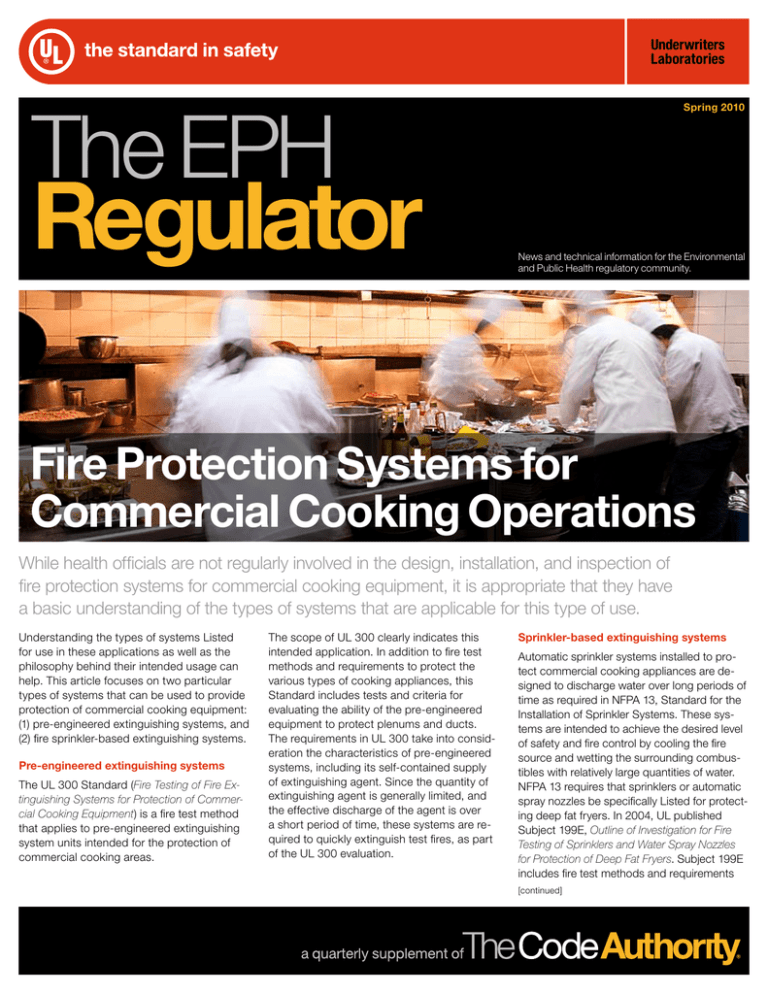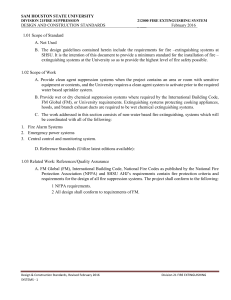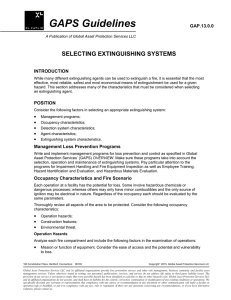
The EPH
Regulator
Spring 2010
News and technical information for the Environmental
and Public Health regulatory community.
Fire Protection Systems for
Commercial Cooking Operations
While health officials are not regularly involved in the design, installation, and inspection of
fire protection systems for commercial cooking equipment, it is appropriate that they have
a basic understanding of the types of systems that are applicable for this type of use.
Understanding the types of systems Listed
for use in these applications as well as the
philosophy behind their intended usage can
help. This article focuses on two particular
types of systems that can be used to provide
protection of commercial cooking equipment:
(1) pre-engineered extinguishing systems, and
(2) fire sprinkler-based extinguishing systems.
Pre-engineered extinguishing systems
The UL 300 Standard (Fire Testing of Fire Extinguishing Systems for Protection of Commercial Cooking Equipment) is a fire test method
that applies to pre-engineered extinguishing
system units intended for the protection of
commercial cooking areas.
The scope of UL 300 clearly indicates this
intended application. In addition to fire test
methods and requirements to protect the
various types of cooking appliances, this
Standard includes tests and criteria for
evaluating the ability of the pre-engineered
equipment to protect plenums and ducts.
The requirements in UL 300 take into consideration the characteristics of pre-engineered
systems, including its self-contained supply
of extinguishing agent. Since the quantity of
extinguishing agent is generally limited, and
the effective discharge of the agent is over
a short period of time, these systems are required to quickly extinguish test fires, as part
of the UL 300 evaluation.
Sprinkler-based extinguishing systems
Automatic sprinkler systems installed to protect commercial cooking appliances are designed to discharge water over long periods of
time as required in NFPA 13, Standard for the
Installation of Sprinkler Systems. These systems are intended to achieve the desired level
of safety and fire control by cooling the fire
source and wetting the surrounding combustibles with relatively large quantities of water.
NFPA 13 requires that sprinklers or automatic
spray nozzles be specifically Listed for protecting deep fat fryers. In 2004, UL published
Subject 199E, Outline of Investigation for Fire
Testing of Sprinklers and Water Spray Nozzles
for Protection of Deep Fat Fryers. Subject 199E
includes fire test methods and requirements
[continued]
The EPH Regulator
UL
for automatic sprinklers and water spray
nozzles intended to provide fire protection for
deep fat fryers and similar appliances.
Since the severity and type of deep fat fryer
fires that are expected to challenge preengineered and sprinkler systems are similar,
the specifications for the fryer and two-minute
pre-burn period described in both UL 300
and Subject 199E are the same. UL 300
requires a deep fat fryer test fire to be fully
extinguished upon complete discharge of the
extinguishing agent, as well as not permitting
re-ignition of the grease.
In comparison, Subject 199E deep fat fryer
test fires are required to be fully extinguished
(continued from cover)
within 15 minutes, and be effectively controlled prior to achieving full extinguishment.
UL Listings for these automatic sprinklers or
spray nozzles are included in the product category VNSY. “Attachments to Sprinkler Systems
Protecting Commercial Cooking Equipment.”
Application considerations
UL standards and test requirements are
developed taking into consideration the attributes of the end-use products as well as the
requirements described in the nationally recognized installation codes and standards. In
addition to the previously mentioned requirements in NFPA 13, both NFPA 96 (Standard
for Ventilation Control and Fire Protection of
Questions & Answers
I tried to locate a listing on your website (www.ul.com) using the “Search UL”
function on your home page. I could not locate the listing even after trying to
search using the manufacturer’s name, model number and UL file number. This
was confusing because a distributor provided a document on UL letterhead
showing that the product was UL Listed. What gives?
The confusion relates to the fact that there are
two separate search functions on the UL website. The “Search UL” function only searches for
keyword information, such as manufacturer’s
name, in the ul.com web pages, not UL’s Certification Directory.
The www.ul.com website includes information
for clients, regulators, consumers, and industry
02
contacts; in short, the information is specific to
UL as an organization, rather than to manufacturers’ certified products.
The information you were trying to verify is
found in the Certifications Directory database.
To access the Certifications Directory, click
on the word “Certifications” link located in the
middle of UL’s home page. This directory allows
you to search by company name, file number,
and keyword, as well as
other search parameters.
If you have difficulty finding what you need, check
out the “Quick Guide”
link, located on the main
“Online Certification
Directory” page, for tips
on searching.
Commercial Cooking Operations) and the
International Fire Code (IFC), include specific installation requirements for protecting
commercial cooking equipment with a variety
of fire protection systems, including both preengineered and sprinkler-based systems.
To determine the applications for which
the systems are Listed, including details on
equipment to be protected, minimum system
requirements and proper nozzle placement,
you should refer to the manufacturers’ installation manual as identified in their Listing
information in UL’s Online Certifications Directory at www.ul.com/database.
(Portions of this article are adapted from an article in
The Code Authority Fall 2004, by Kerry Bell).
Environmental and
Public Health Code
Authorities Web Page
For many years, UL has provided a web
page with information relevant to Environmental and Public Health regulatory
officials. We are pleased to announce
that this page has been updated as of
February 1, 2010. You will find it much
easier to access information on certified
products, as well as additional technical
information on food, water, and swimming pool topics.
Give it a try here … and let us know what
you think!
m/eph
o
c
ul.
Fire Protection Systems
Spring 2010
We want our website to
be user friendly and we
welcome your comments
and feedback.
The EPH Regulator
a supplement of The Code Authority®
© 2010. All rights reserved.
Published by the Regulatory Services
Department of Underwriters Laboratories Inc.
Managing Editor: Jim Dingman
+1.847.664.1579
James.D.Dingman@us.ul.com
www.ul.com/ephregulator



